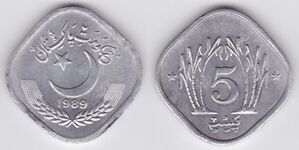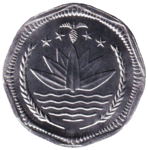بيسة
بيسة (هندي: पैसा,گجراتي: પૈસા, Marathi: पैसे, Nepali/هندي: पैसा, أردو: پیسہ), poysha (بالبنغالية: পয়সা) or baisa (Omani: بيسة) هي وحدة نقدية في العديد من البلدان. في الهند ونيبال وباكستان، تساوي البيسة حالياً 1/100 من الروبية. في بنگلادش، يساوي بويشا 1/100 من التاكا البنغلاديشية. في سلطنة عمان، تساوي البيسة 1/1000 ريال عماني.
علم أصول الكلمات
كلمة "paisa" مأخوذة من المصطلح السنسكريتية "Padāṁśa (الوحدة الأساسية)" ، والتي تعني "ربع أو جزء أو القاعدة" ، من "pada" "القدم أو الربع أو القاعدة" و "aṁśa "" "جزء أو وحدة".[1][2] كان البيسة مستخدمًا أيضًا في كينيا الاستعمارية. المصطلح العامي للمال في البورمية ، "paiksan "(ပိုက်ဆံ)، مشتق من المصطلح الهندي "paisa".[3]
التاريخ
Chaulukya coins were often called "Gadhaiya Paise" (9th-10th century AD).[4] Until the 1950s in India and Pakistan (and before 1947 in British India), the paisa was equivalent to 3 pies, 1⁄4 of an anna, or 1⁄64 of a rupee. After the transition from a non-decimal currency to a decimal currency, the paisa equaled 1⁄100 of a rupee and was known as a naya paisa ("new paisa") for a few years to distinguish it from the old paisa that was 1⁄64 of a rupee.
المصطلح
In Hindi, Bengali, Afghan Persian, Urdu, Nepali and other languages, the word paisa often means money or cash. Medieval trade routes that spanned the Arabian Sea between India, the Arab regions and East Africa spread the usage of Indian subcontinent and Arabic currency terms across these areas.[5] The word pesa as a reference to money in East African languages such as Swahili dates from that period.[5] An example of this usage is the older day Kenyan mobile-phone-based money transfer service M-Pesa (which stands for "mobile pesa" or "mobile money").
الاستخدام
- بويشا (Poisha) = 1⁄100 من تاكا بنگلادشي (لم يعد متداولًا)
- بيسا (Paisa) = 1⁄100 من روبية هندية (لم تعد متداوله)
- بايسا (Paisa) = 1⁄100 من روبية نيبالية
- بيسة (Baisa) = 1⁄1000 من ريال عماني
- بيسا (Paisa) = 1⁄100 من روبية باكستانية (تم إلغاء التداول رسميًا اعتبارًا من 1 أكتوبر 2014)
معرض الصور
انظر أيضاً
المصادر
- ^ "paisa". Free Merriam-Webster Dictionary. Merriam-Webster. Retrieved 3 February 2015.
- ^ "pada". spokensanskrit.de (version 4.2). Retrieved 3 February 2015.
- ^ Myanmar-English Dictionary. Myanmar Language Commission. ISBN 1-881265-47-1.
- ^ Ray, Himanshu Prabha (2019). Negotiating Cultural Identity: Landscapes in Early Medieval South Asian History (in الإنجليزية). Taylor & Francis. pp. 161–163. ISBN 9781000227932.
- ^ أ ب Jeffreys, M. D. W. (1953). "Cowry: Ndoro". NADA: The Southern Rhodesia Native Affairs Department Annual. Government of Southern Rhodesia (30). Retrieved 3 February 2015.
...currency terms pesa, upeni, mali, khete, tickey all derive from Hindu or Arabic currency terms still in use in what was once called the Erythraean Sea
وصلات خارجية
- Articles containing هندي-language text
- Articles containing گجراتي-language text
- Pages using Lang-xx templates
- Articles containing أردو-language text
- Articles containing بنغالي-language text
- Pages with empty portal template
- Rupee
- Currencies of Asia
- Currencies of Bangladesh
- Coins of India
- Coins of Pakistan
- Economy of Nepal
- اقتصاد پاكستان




